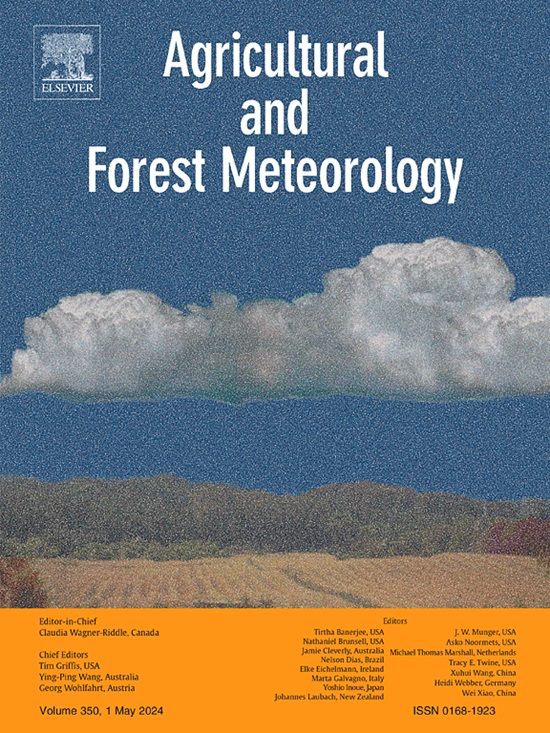在大气CO2升高的情况下,冠层电导没有广泛下降
IF 5.7
1区 农林科学
Q1 AGRONOMY
引用次数: 0
摘要
叶片气孔导度和蒸腾速率通常被认为在CO2浓度升高(eCO2)下通过部分气孔关闭而下降。虽然这对陆地碳和水文平衡具有重要意义,但在生态系统尺度上,eCO2对气孔导度和蒸腾的影响仍存在很大争议。本文利用78个涡动相关点的全球生态系统水平测量数据,研究了冠层电导(Gc)的长期变化趋势。利用经验冠层电导模型量化了CO2、总初级生产量(GPP)和蒸汽压差(D)对Gc (dGc/dt)变化趋势的分别贡献。我们发现,78个站点中的大多数没有明显的Gc趋势。只有15个站点呈现显著的dGc/dt趋势,但趋势方向在这些站点之间并不一致。GPP对Gc变化的贡献最大。D对Gc具有重要的调节作用,即使在eCO2条件下,有利的气候条件和低D也增加了Gc。叶片环境CO2浓度(Ca)对Gc的影响一致且相对较弱。此外,最新的陆地表面模型(CLM5.0)系统地低估了这78个站点的Gc,该模型还显示CO2对Gc的调节作用更强,而D的调节作用较弱。我们的研究结果表明,eCO2对Gc缺乏广泛的影响,最先进的陆地表面模型无法准确捕捉Gc趋势。结果表明,这些地球系统模型在大尺度上可能高估了气孔对eCO2响应的蒸散发抑制作用。我们的发现可以帮助改进模型,更好地预测在二氧化碳上升和气候变化背景下Gc、蒸散发和径流的未来变化。本文章由计算机程序翻译,如有差异,请以英文原文为准。
No widespread decline in canopy conductance under elevated atmospheric CO2
Leaf stomatal conductance and transpiration rates have been commonly presumed to decline under elevated CO2 concentrations (eCO2) via partial stomatal closure. While this has great implications for the terrestrial carbon and hydrological balances, eCO2 effects on stomatal conductance and transpiration at the ecosystem scale are highly debatable. Here, we used global ecosystem-level measurements from 78 eddy covariance sites to study long-term trends in canopy conductance (Gc). An empirical canopy conductance model was also used to quantify the separate contributions of CO2, gross primary production (GPP), and vapor pressure deficit (D) to the trends in Gc (dGc/dt). We found that the majority of the 78 sites did not have a significant trend in Gc. Only 15 sites exhibited significant dGc/dt trends, while the direction of the trends was not consistent across these sites. GPP contributed the most to the change in Gc. D played an essential role in regulating Gc, and favorable climates and low D increased Gc even under eCO2. Leaf ambient CO2 concentration (Ca) had a consistent and relatively weak yet negative effect on Gc at most sites. Moreover, a state-of-the-art land surface model (CLM5.0) systematically underestimated Gc for these 78 sites and the model also exhibited a stronger role for CO2 but a weaker role for D in regulating Gc. Our results reveal the lack of widespread effects of eCO2 on Gc, and a state-of-the-art land surface model is unable to accurately capture the Gc trends. Our results indicate that the stomatal suppression of evapotranspiration in response to eCO2 may have been overestimated by these earth system models at large scales. Our findings can help improve models and better project future changes in Gc, evapotranspiration, and runoff in the context of rising CO2 and climate change.
求助全文
通过发布文献求助,成功后即可免费获取论文全文。
去求助
来源期刊
CiteScore
10.30
自引率
9.70%
发文量
415
审稿时长
69 days
期刊介绍:
Agricultural and Forest Meteorology is an international journal for the publication of original articles and reviews on the inter-relationship between meteorology, agriculture, forestry, and natural ecosystems. Emphasis is on basic and applied scientific research relevant to practical problems in the field of plant and soil sciences, ecology and biogeochemistry as affected by weather as well as climate variability and change. Theoretical models should be tested against experimental data. Articles must appeal to an international audience. Special issues devoted to single topics are also published.
Typical topics include canopy micrometeorology (e.g. canopy radiation transfer, turbulence near the ground, evapotranspiration, energy balance, fluxes of trace gases), micrometeorological instrumentation (e.g., sensors for trace gases, flux measurement instruments, radiation measurement techniques), aerobiology (e.g. the dispersion of pollen, spores, insects and pesticides), biometeorology (e.g. the effect of weather and climate on plant distribution, crop yield, water-use efficiency, and plant phenology), forest-fire/weather interactions, and feedbacks from vegetation to weather and the climate system.

 求助内容:
求助内容: 应助结果提醒方式:
应助结果提醒方式:


